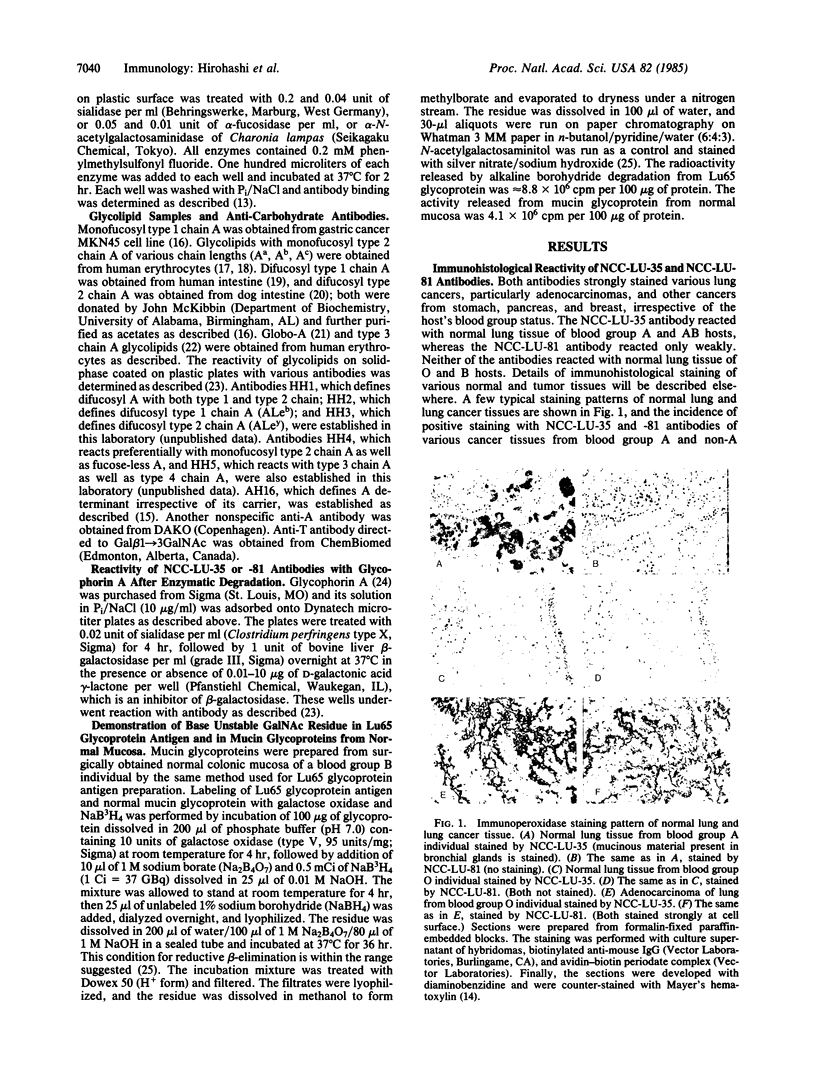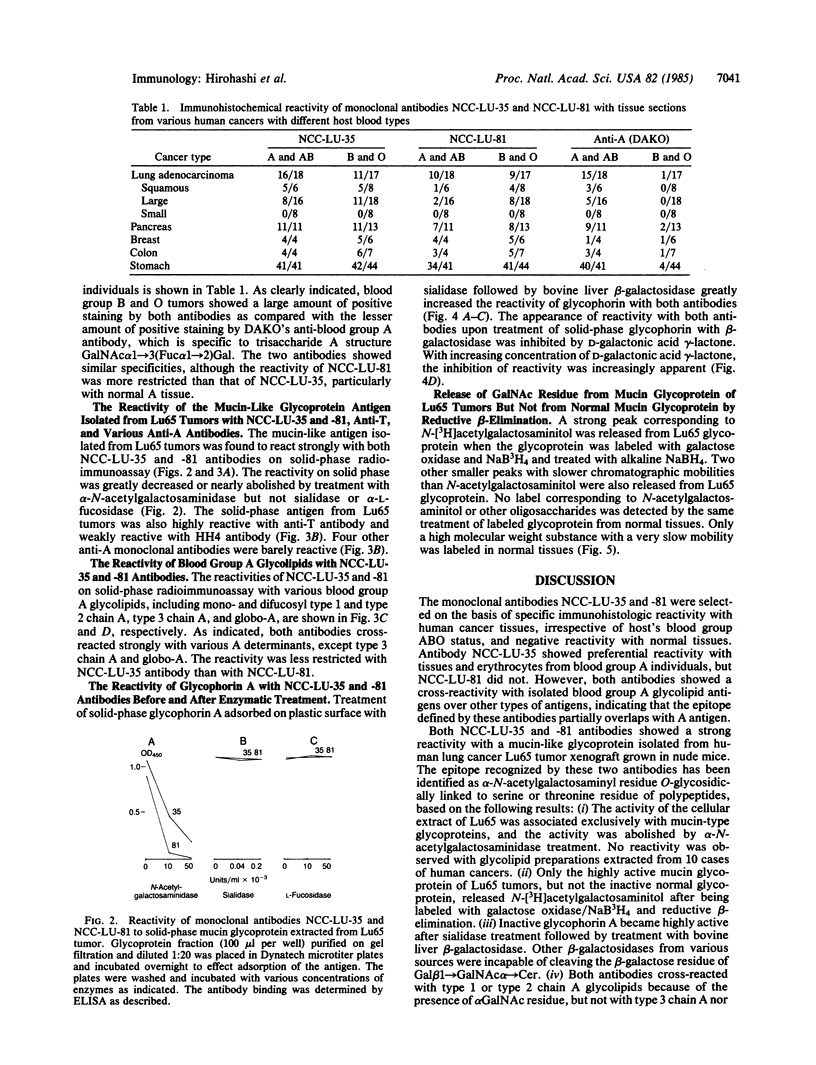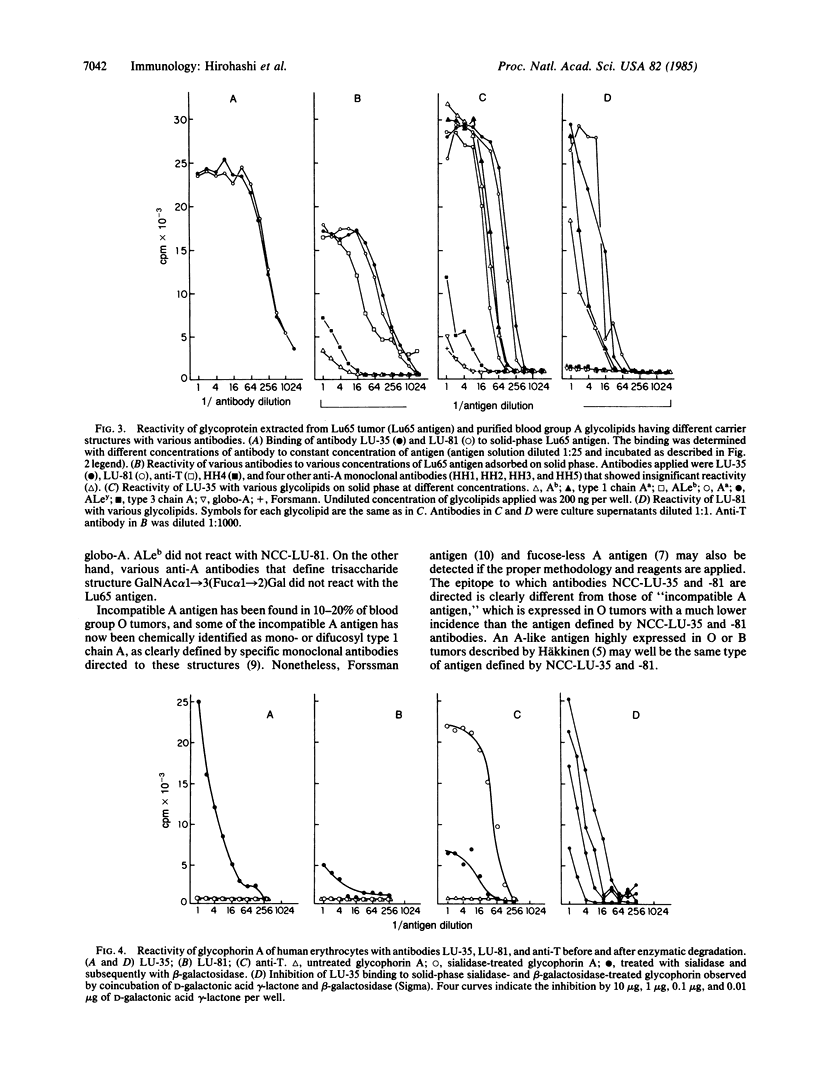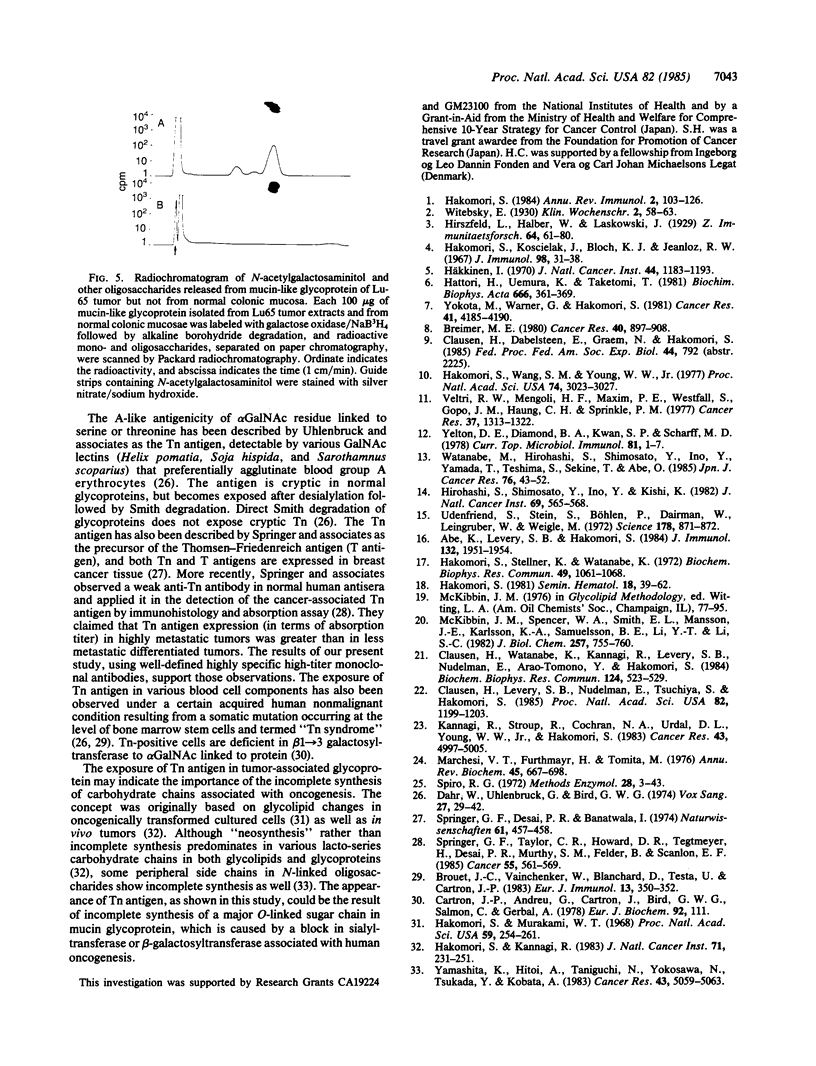Abstract
Two monoclonal antibodies, NCC-LU-35 and NCC-LU-81, have been established after immunization of mice with membrane preparations of human lung cancer Lu65 tumor xenograft cells grown in vivo and intact cells cultured in vitro, respectively. These two antibodies react specifically with a majority of human adenocarcinomas, irrespective of the host's blood group ABO status, as well as with normal tissues and erythrocytes of blood group A individuals. The antigenicity is associated with a high molecular weight mucin-like glycoprotein separated by gel filtration of Lu65 tumor extracts. The epitope of the mucin-like glycoprotein has been identified as alpha-N-acetylgalactosaminyl residue directly linked O-glycosidically to serine or threonine residues of polypeptides. This epitope was serologically detected several years ago and given the name Tn. Our identification of the epitope is based on the following results: The antigen is sensitive to alpha-N-acetylgalactosaminidase, but not to sialidase or alpha-fucosidase. Various mono- and difucosyl A determinants, either type 1 or type 2 chain, cross-react with both antibodies. The reactivity with both antibodies can be created by treatment of glycophorin A of normal erythrocytes with sialidase followed by beta-galactosidase. N-[3H]acetylgalactosamine can be released by galactose oxidase/NaB3H4 treatment from the Lu65 mucin-like glycoprotein but not from the mucin-like glycoprotein of normal colonic mucosa upon reductive beta-elimination (alkaline borohydride treatment). The antigen may be one of the tumor-associated A cross-reacting antigens occurring in a wide variety of human adenocarcinomas of hosts belonging to all ABO blood groups.
Full text
PDF




Images in this article
Selected References
These references are in PubMed. This may not be the complete list of references from this article.
- Abe K., Levery S. B., Hakomori S. The antibody specific to type 1 chain blood group A determinant. J Immunol. 1984 Apr;132(4):1951–1954. [PubMed] [Google Scholar]
- Breimer M. E. Adaptation of mass spectrometry for the analysis of tumor antigens as applied to blood group glycolipids of a human gastric carcinoma. Cancer Res. 1980 Mar;40(3):897–908. [PubMed] [Google Scholar]
- Brouet J. C., Vainchenker W., Blanchard D., Testa U., Cartron J. P. The origin of human B and T cells from multipotent stem cells: a study of the Tn syndrome. Eur J Immunol. 1983 Apr;13(4):350–352. doi: 10.1002/eji.1830130416. [DOI] [PubMed] [Google Scholar]
- Cartron J. P., Andreu G., Cartron J., Bird G. W., Salmon C., Gerbal A. Demonstration of T-transferase deficiency in Tn-polyagglutinable blood samples. Eur J Biochem. 1978 Dec 1;92(1):111–119. doi: 10.1111/j.1432-1033.1978.tb12728.x. [DOI] [PubMed] [Google Scholar]
- Clausen H., Levery S. B., Nudelman E., Tsuchiya S., Hakomori S. Repetitive A epitope (type 3 chain A) defined by blood group A1-specific monoclonal antibody TH-1: chemical basis of qualitative A1 and A2 distinction. Proc Natl Acad Sci U S A. 1985 Feb;82(4):1199–1203. doi: 10.1073/pnas.82.4.1199. [DOI] [PMC free article] [PubMed] [Google Scholar]
- Clausen H., Watanabe K., Kannagi R., Levery S. B., Nudelman E., Arao-Tomono Y., Hakomori S. Blood group A glycolipid (Ax) with globo-series structure which is specific for blood group A1 erythrocytes: one of the chemical bases for A1 and A2 distinction. Biochem Biophys Res Commun. 1984 Oct 30;124(2):523–529. doi: 10.1016/0006-291x(84)91585-7. [DOI] [PubMed] [Google Scholar]
- Dahr W., Uhlenbruck G., Bird G. W. Cryptic A-like receptor sites in human erythrocyte glycoproteins: proposed nature of Tn-antigen. Vox Sang. 1974;27(1):29–42. doi: 10.1111/j.1423-0410.1974.tb02386.x. [DOI] [PubMed] [Google Scholar]
- Hakomori S. I., Koscielak J., Bloch K. J., Jeanloz R. W. Immunologic relationship between blood group substances and a fucose-containing glycolipid of human adenocarcinoma. J Immunol. 1967 Jan;98(1):31–38. [PubMed] [Google Scholar]
- Hakomori S. I., Murakami W. T. Glycolipids of hamster fibroblasts and derived malignant-transformed cell lines. Proc Natl Acad Sci U S A. 1968 Jan;59(1):254–261. doi: 10.1073/pnas.59.1.254. [DOI] [PMC free article] [PubMed] [Google Scholar]
- Hakomori S. Blood group ABH and Ii antigens of human erythrocytes: chemistry, polymorphism, and their developmental change. Semin Hematol. 1981 Jan;18(1):39–62. [PubMed] [Google Scholar]
- Hakomori S., Kannagi R. Glycosphingolipids as tumor-associated and differentiation markers. J Natl Cancer Inst. 1983 Aug;71(2):231–251. [PubMed] [Google Scholar]
- Hakomori S., Stellner K., Watanabe K. Four antigenic variants of blood group A glycolipid: examples of highly complex, branched chain glycolipid of animal cell membrane. Biochem Biophys Res Commun. 1972 Nov 15;49(4):1061–1068. doi: 10.1016/0006-291x(72)90320-8. [DOI] [PubMed] [Google Scholar]
- Hakomori S. Tumor-associated carbohydrate antigens. Annu Rev Immunol. 1984;2:103–126. doi: 10.1146/annurev.iy.02.040184.000535. [DOI] [PubMed] [Google Scholar]
- Hakomori S., Wang S. M., Young W. W., Jr Isoantigenic expression of Forssman glycolipid in human gastric and colonic mucosa: its possible identity with "A-like antigen" in human cancer. Proc Natl Acad Sci U S A. 1977 Jul;74(7):3023–3027. doi: 10.1073/pnas.74.7.3023. [DOI] [PMC free article] [PubMed] [Google Scholar]
- Hattori H., Uemura K., Taketomi T. The presence of blood group A-active glycolipids in cancer tissues from blood group O patients. Biochim Biophys Acta. 1981 Dec 23;666(3):361–369. doi: 10.1016/0005-2760(81)90295-2. [DOI] [PubMed] [Google Scholar]
- Hirohashi S., Shimosato Y., Ino Y., Kishi K. Distribution of hepatitis B surface and core antigens in human liver cell carcinoma and surrounding nontumorous liver. J Natl Cancer Inst. 1982 Sep;69(3):565–568. [PubMed] [Google Scholar]
- Häkkinen I. A-like blood group antigen in gastric cancer cells of patients in blood groups Q or B. J Natl Cancer Inst. 1970 May;44(5):1183–1193. [PubMed] [Google Scholar]
- Kannagi R., Stroup R., Cochran N. A., Urdal D. L., Young W. W., Jr, Hakomori S. Factors affecting expression of glycolipid tumor antigens: influence of ceramide composition and coexisting glycolipid on the antigenicity of gangliotriaosylceramide in murine lymphoma cells. Cancer Res. 1983 Oct;43(10):4997–5005. [PubMed] [Google Scholar]
- Marchesi V. T., Furthmayr H., Tomita M. The red cell membrane. Annu Rev Biochem. 1976;45:667–698. doi: 10.1146/annurev.bi.45.070176.003315. [DOI] [PubMed] [Google Scholar]
- McKibbin J. M., Spencer W. A., Smith E. L., Mansson J. E., Karlsson K. A., Samuelsson B. E., Li Y. T., Li S. C. Lewis blood group fucolipids and their isomers from human and canine intestine. J Biol Chem. 1982 Jan 25;257(2):755–760. [PubMed] [Google Scholar]
- Springer G. F., Desai P. R., Banatwala I. Blood group MN specific substances and precursors in normal and malignant human breast tissues. Naturwissenschaften. 1974 Oct;61(10):457–458. doi: 10.1007/BF00597216. [DOI] [PubMed] [Google Scholar]
- Springer G. F., Taylor C. R., Howard D. R., Tegtmeyer H., Desai P. R., Murthy S. M., Felder B., Scanlon E. F. Tn, a carcinoma-associated antigen, reacts with anti-Tn of normal human sera. Cancer. 1985 Feb 1;55(3):561–569. doi: 10.1002/1097-0142(19850201)55:3<561::aid-cncr2820550315>3.0.co;2-1. [DOI] [PubMed] [Google Scholar]
- Udenfriend S., Stein S., Böhlen P., Dairman W., Leimgruber W., Weigele M. Fluorescamine: a reagent for assay of amino acids, peptides, proteins, and primary amines in the picomole range. Science. 1972 Nov 24;178(4063):871–872. doi: 10.1126/science.178.4063.871. [DOI] [PubMed] [Google Scholar]
- Veltri R. W., Mengoli H. F., Maxim P. E., Westfall S., Gopo J. M., Hauang C. W., Sprinkle P. M. Isolation and identification of human lung tumor-associated antigens. Cancer Res. 1977 May;37(5):1313–1322. [PubMed] [Google Scholar]
- Watanabe M., Hirohashi S., Shimosato Y., Ino Y., Yamada T., Teshima S., Sekine T., Abe O. Carbohydrate antigen defined by a monoclonal antibody raised against a gastric cancer xenograft. Jpn J Cancer Res. 1985 Jan;76(1):43–52. [PubMed] [Google Scholar]
- Yamashita K., Hitoi A., Taniguchi N., Yokosawa N., Tsukada Y., Kobata A. Comparative study of the sugar chains of gamma-glutamyltranspeptidases purified from rat liver and rat AH-66 hepatoma cells. Cancer Res. 1983 Nov;43(11):5059–5063. [PubMed] [Google Scholar]
- Yelton D. E., Diamond B. A., Kwan S. P., Scharff M. D. Fusion of mouse myeloma and spleen cells. Curr Top Microbiol Immunol. 1978;81:1–7. doi: 10.1007/978-3-642-67448-8_1. [DOI] [PubMed] [Google Scholar]
- Yokota M., Warner G. A., Hakomori S. Blood group A-like glycolipid and a novel Forssman antigen in the hepatocarcinoma of a blood group O individual. Cancer Res. 1981 Oct;41(10):4185–4190. [PubMed] [Google Scholar]









